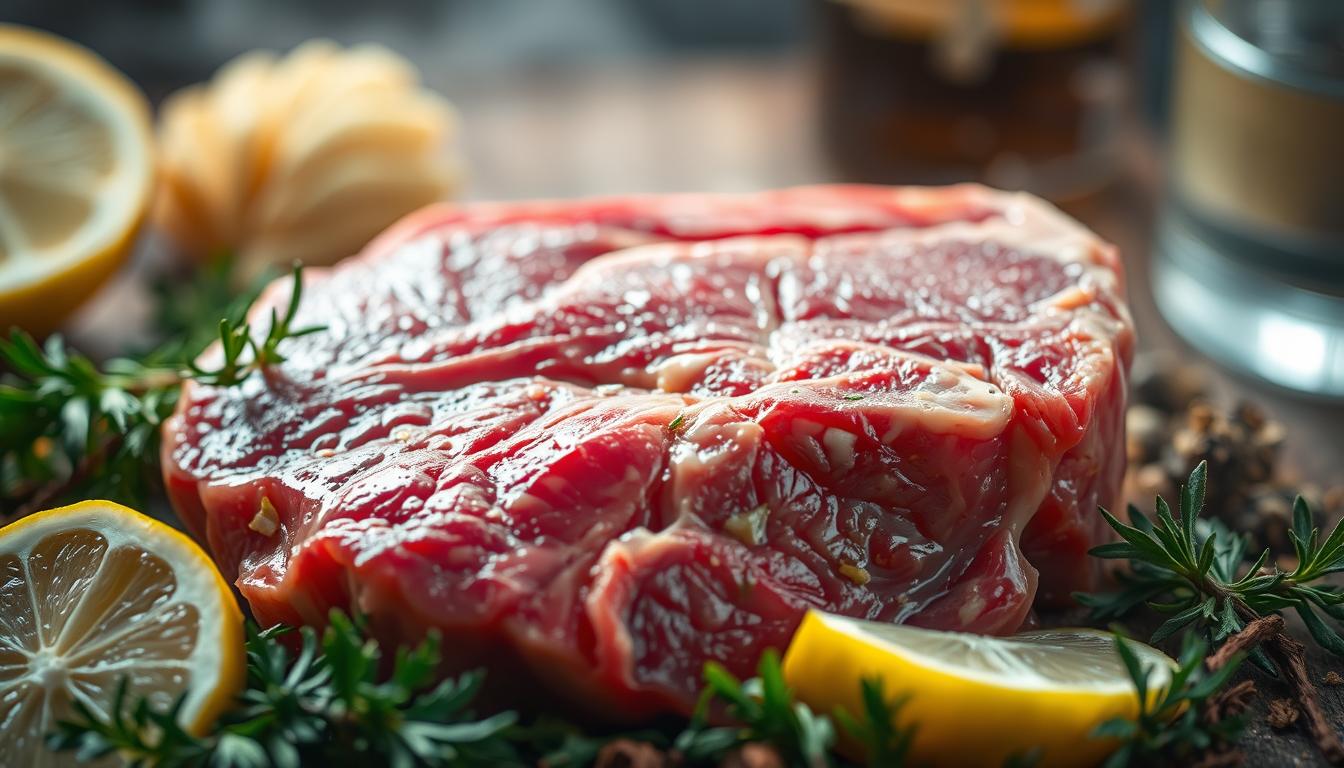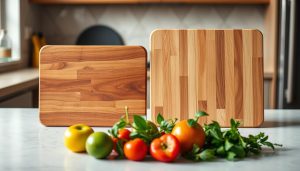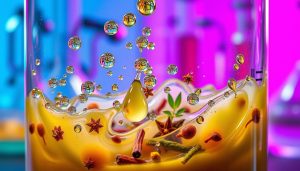Did you know a simple citrus-based soak can break down 30% of collagen in certain cuts within hours? This transformation isn’t magic—it’s science. Understanding how proteins and connective tissues interact with everyday ingredients unlocks the secret to turning chewy slabs into succulent masterpieces.
Every cut contains muscle fibers built from proteins like actin and myosin. These strands give structure but also create toughness. Surrounding them is collagen, a connective tissue that melts when exposed to specific elements. Traditional cooking methods alone can’t achieve this breakdown—but targeted soaking methods do.
For centuries, cultures worldwide have used soaking solutions to preserve and enhance food. What began as a practical way to extend shelf life evolved into a culinary art. Today, these mixtures don’t just add flavor—they reshape texture at the molecular level.
By grasping these principles, you gain control over results. Whether grilling, roasting, or braising, the right approach ensures consistently tender dishes. Let’s explore how this process works and why it’s a game-changer for home cooks and chefs alike.
Key Takeaways
- Muscle fibers and collagen determine a cut’s texture, requiring specific methods to soften effectively.
- Natural ingredients in soaking solutions interact with proteins to break down tough structures.
- Historical preservation techniques laid the foundation for modern flavor and texture enhancement.
- Proper application of these principles elevates dishes across cooking styles.
- Understanding molecular interactions helps achieve predictable, restaurant-quality results.
Understanding the Science Behind Acidic Marinades
Have you ever wondered why lime juice makes chicken softer or yogurt transforms tough lamb? The answer lies in chemistry. Certain kitchen staples contain molecules that rearrange meat’s building blocks at microscopic levels.

The Role of Acids in Protein Denaturation
When you soak meat in vinegar or citrus, hydrogen ions from these liquids penetrate its surface. These charged particles disrupt bonds holding protein strands together. Actin and myosin—key components in muscle fibers—unfold like coiled ropes, creating space for moisture retention.
This unraveling process, called denaturation, occurs gradually. Unlike heat-based cooking that rapidly changes texture, acidic solutions work over hours. A pH below 5 proves most effective, breaking bonds without dissolving tissues completely.
Impact on Collagen and Muscle Fibers
While acids primarily target muscle proteins, they also weaken collagen networks. Connective tissues become more pliable as their cross-linked structure loosens. However, excessive exposure can turn meat mushy—balance matters.
Thicker cuts benefit most from this dual action. The outer layers soften while inner tissues remain intact, ensuring even tenderness during cooking. Timing varies: delicate fish needs minutes, while beef brisket might soak overnight.
Understanding Why Acidic Marinades Tenderize Meat
The secret to transforming tough cuts lies in three simple components working in harmony. Every effective marinade combines oil, seasonings, and an acidic element—each playing a distinct role in reshaping texture and flavor.

Key Chemical Interactions in Marinades
Oil acts as a carrier for fat-soluble flavors while creating a protective layer that locks in moisture. Herbs and spices infuse taste, but the acidic component—like vinegar or citrus—does the heavy lifting. These solutions disrupt protein bonds, softening the surface layers of your ingredients.
Meat’s high water content (about 75%) creates a natural barrier. This limits acid penetration to just 2-3 millimeters—a critical detail for timing your marinating process. Thinner cuts benefit most, as the solution reaches deeper into the tissue.
Balancing Acidity and Moisture
Overexposure to acidic elements causes proteins to tighten excessively, squeezing out juices. For chicken or fish, 30 minutes often suffices. Tougher cuts like pork shoulder can handle 4-12 hours. Always refrigerate during soaking to slow reactions and prevent mushiness.
Pair acids with oils and aromatics to buffer their intensity. This balance preserves moisture while achieving desired tenderness. For deeper insights into these reactions, explore the science of food and cooking behind everyday techniques.
Enzymes and Other Natural Tenderizers
Nature’s secret to perfect texture hides in unexpected places—your fruit bowl. Unlike acidic solutions, certain fruits contain biological tools that reshape proteins with surgical precision. These natural catalysts work faster than vinegar or citrus, transforming tough cuts without overpowering flavors.
Fruit-Based Enzymes: Pineapple, Papaya, and Kiwi
Papaya delivers papain, an enzyme targeting collagen and muscle fibers. It’s ideal for dense cuts like chuck roast. Pineapple contains bromelain, which excels at dismantling connective tissues in flank steak. Kiwi offers actinidin—a gentler option for chicken or fish.

Fresh juice works best—canned versions lose potency due to heat processing. Blend crushed fruit into pastes or mix juices with oils for balanced marinades. Always strain pulps to ensure even coating.
Timing and Temperature Considerations
Enzymatic action accelerates at room temperature. For safety, marinate in the fridge but limit soaking time. Thin cuts need 20-60 minutes. Thicker portions require 1-3 hours—never exceed 3 hours, or textures turn mushy.
| Enzyme | Source | Optimal Time | Best For |
|---|---|---|---|
| Papain | Papaya | 2-3 hours | Beef, pork |
| Bromelain | Pineapple | 1-2 hours | Flank steak |
| Actinidin | Kiwi | 30-60 mins | Poultry, fish |
Monitor thicker cuts closely. Enzymes penetrate deeper over time, especially in vacuum-sealed bags. For predictable results, test small portions first.
Practical Tips for Marinating and Flavoring Your Meat
Crafting the perfect balance between texture and taste starts with smart ingredient pairings. Combine citrus or vinegar with olive oil to create a protective layer that locks in moisture while softening surface fibers. Fresh herbs like rosemary or thyme add aromatic depth without overpowering delicate proteins.
Effective Techniques to Enhance Flavor
Thinner cuts like chicken breasts or pork chops absorb solutions faster. Marinate them 30-90 minutes—enough time for flavors to penetrate without causing mushiness. For roasts, slice into 2-inch cubes or use a meat injector to distribute mixtures evenly.
Swap table salt with soy sauce in your recipes. Its glutamic acid boosts umami richness while contributing to tenderization. Add honey or brown sugar to counteract sharpness in citrus-based blends and promote caramelization during cooking.
| Marinade Type | Key Ingredients | Optimal Time | Best For |
|---|---|---|---|
| Acidic | Lemon juice, olive oil, garlic | 1-3 hours | Chicken, fish |
| Enzymatic | Pineapple, papaya, yogurt | 20-90 minutes | Beef skirt, pork shoulder |
| Fermented | Soy sauce, miso, wine | 4-24 hours | Lamb, brisket |
Always pat meat dry before grilling or searing. Excess liquid steams instead of browning, creating less flavorful crusts. Store marinating proteins in sealed containers on the fridge’s bottom shelf to prevent cross-contamination.
Conclusion
Mastering the art of tenderizing isn’t just about recipes—it’s about chemistry. By understanding how solutions interact with proteins and connective tissues, you unlock consistent results. Whether using citrus-based blends or fruit enzymes, each method reshapes texture through precise reactions.
Timing proves crucial. Overexposure to strong elements can damage surface fibers, while balanced mixtures enhance both tenderness and flavor. Thinner cuts respond faster than dense roasts, requiring adjusted soaking periods.
Your newfound knowledge lets you approach various cuts with confidence. Pair oils with acidic components to protect moisture. Apply enzymatic options for rapid breakdown without overpowering natural tastes. Every choice impacts the final dish’s structure.
Experimentation becomes your greatest tool. With core principles guiding your process, create custom blends that transform challenging textures into succulent masterpieces. The science is clear—your culinary skills just leveled up.



